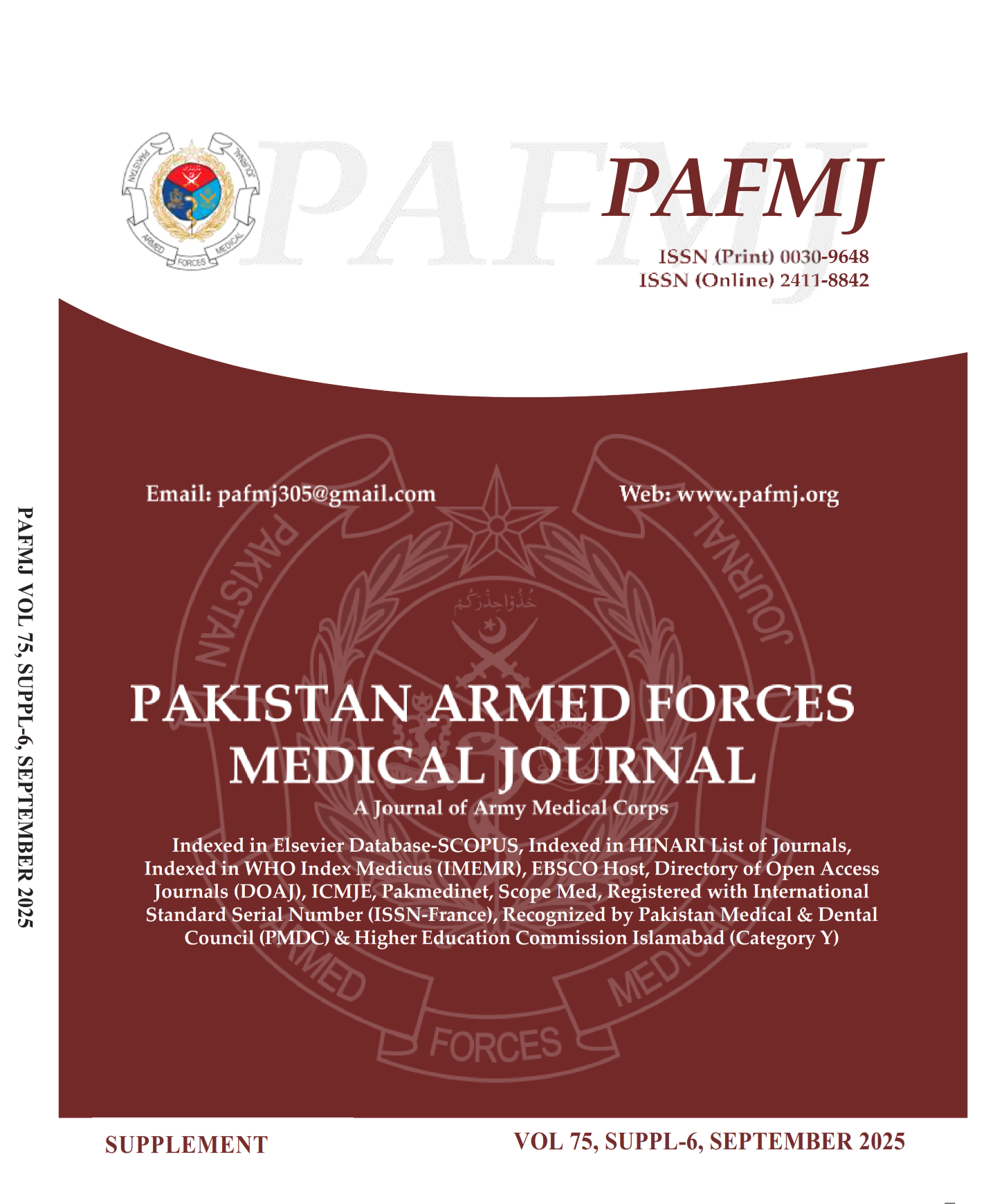Validity of Ultrasonography for Detection of Renal and Ureteric Calculi in Patients of Renal Colic Keeping CT Scan as a Gold Standard
DOI:
https://doi.org/10.51253/pafmj.v75iSUPPL-6.7727Keywords:
CT, Diagnostic, Renal Colic, UltrasonographyAbstract
Objectives: To assess the validity of ultrasonography (USG) for detection of renal and ureteric calculi in patients of renal colic by taking computerized tomography (CT) scan as a gold standard.
Study Design: Cross-sectional analytical study.
Place and Duration of Study: KRL General Hospital, Islamabad Pakistan, from Jan to Dec 2019.
Methodology: 110 patients with suspected renal colic presenting in emergency and outpatient departments were recruited through non-probability convenience sampling. Both adult female and male patients irrespective of their age, fulfilling the inclusion criteria were included. Transabdominal USG and unenhanced CT of all patients were performed, and findings were recorded.
Results: CT scan was taken as gold standard and sensitivity, specificity, positive predictive values, negative predictive values, and diagnostic accuracy of ultrasound in detecting renal calculi were 73.08%, 94.83%, 92.68%, 79.71%, and 84.54% respectively. While these values in detecting ureteric calculi by USG were 14.81%, 89.65%, 80%, 27.37% and 34.54% respectively.
Conclusion: Ultrasonography (USG) can be used to identify renal calculi on the x-ray in patients with renal colic, but it is less effective at detecting ureteric calculi. CT is reserved for cases where ultrasonography is unable to provide conclusive results due to the higher costs and ionizing radiation risks.
Downloads
References
1. Patti L, Leslie SW. Acute Renal Colic. In: StatPearls. Treasure Island (FL): StatPearls Publishing; 2021 Jan.
https://www.ncbi.nlm.nih.gov/books/NBK431091/
2. Van Batavia JP, Tasian GE. Clinical effectiveness in the diagnosis and acute management of pediatric nephrolithiasis. Int J Surg 2016; 36(Pt D): 698-704.
https://doi.org/10.1016/j.ijsu.2016.11.030
3. Iqbal N, Chughtai N. Diagnosis and management of uric acid nephrolithiasis. Annals of KEMU 2016, 10(2), 175-178.
https://doi.org/10.21649/akemu.v10i2.1199
4. Leslie SW, Sajjad H, Murphy PB. Renal Calculi. In: StatPearls. Treasure Island (FL): StatPearls Publishing; 2021 Jan.
https://www.ncbi.nlm.nih.gov/books/NBK442014/
5. Lim GS, Jang SH, Son JH, et al. Comparison of Non-contrast-Enhanced Computed Tomography and Intravenous Pyelogram for Detection of Patients With Urinary Calculi. Korean J Urol 2014; 55(2): 120-123. https://doi.org/10.4111/kju.2014.55.2.120
6. Rodger F, Roditi G, Aboumarzouk O, et al. Diagnostic Accuracy of Low and Ultra-Low Dose CT for Identification of Urinary Tract Stones: A Systematic Review. Urol Int 2018; 100: 375-385.
https://doi.org/10.1159/000488062
7. Souza LRMF, Faintuch S, De Nicola H, et al. A tomografia computadorizada helicoidal no diagnóstico da litíase ureteral. Sao Paulo Med J 2007; 125(2): 102-107.
8. Elibol O, Safak KY, Buz A, et al. Radiological noninvasive assessment of ureteral stone impaction into the ureteric wall: A critical evaluation with objective radiological parameters. Investig Clin Urol 2017; 58(5): 339-345.
https://doi.org/10.4111/icu.2017.58.5.339
9. MS Shaaban, AF Kotb. Value of non-contrast CT examination of the urinary tract (stone protocol) in the detection of incidental findings and its impact upon the management. Alxndria J of Med 2016: 55(3): 209-217. https://doi.org/10.1016/j.ajme.2015.08.001
10. Vijayakumar M, Ganpule A, Singh A, et al. Review of techniques for ultrasonic determination of kidney stone size. RRes Rep Urol 2018: (10): 57-61. https://doi.org/10.2147/RRU.S128039
11. Liu Y, Chen Y, Liao B, Luo D, Wang K, Li H, et al. Epidemiology of urolithiasis in Asia. Asian J Urol 2018; 5(4): 205-214.
https://doi.org/10.1016/j.ajur.2018.08.007
12. Ahmed F, Askarpour MR, Eslahi A, et al. The role of ultrasonography in detecting urinary tract calculi compared to CT scan. Res Rep Urol 2018; 10: 199-203.
https://doi.org/10.2147/RRU.S178902
13. Brisbane W, Bailey M, Sorensen M. An overview of kidney stone imaging techniques. Nat Rev Urol 2016: 13(11): 654–662.
https://doi.org/10.1038/nrurol.2016.154
14. McCarthy CJ, Baliyan V, Kordbacheh H, et al. Radiology of renal stone disease. Int J Surg 2016; 36(Pt D): 638-46.
https://doi.org/10.1016/j.ijsu.2016.10.045
15. Mahajan M, Hogewoning J A, Zewald J J A, et al. The impact of teach-back on patient recall and understanding of discharge information in the emergency department: The Emergency Teach-Back (EM-TeBa) study. Int J Emerg Med 2020: 13(49).
https://doi.org/10.1186/s12245-020-00306-9
16. S Hasan, R Muhammad, Raziq et al. Diagnostic Accuracy of Ultrasonography Versus Computed Tomography in Patients of Acute Renal Colic. P J M H S 2019; 13(4): 918-921.
17. Ganesan V, De S, Greene D, et al. Accuracy of ultrasonography for renal stone detection and size determination: is it good enough for management decisions? BJU Int 2017; 119(3): 464-469.
https://doi.org/10.1111/bju.13605
18. Thakur A P S, Sharma V, Ramasamy V, et al. Management of ureteric stone in pregnancy: a review. Afr J Urol 2020: 26(60).
https://doi.org/10.1186/s12301-020-00070-5
19. Ahmed F, Askarpour MR, Eslahi A, et al. The role of ultrasonography in detecting urinary tract calculi compared to CT scan. Res Rep Urol 2018; 10: 199-203.
https://doi.org/10.2147/RRU.S178902
20. Nery, Daniela Rebouças et al. Epidemiological and imaging features that can affect the detection of ureterolithiasis on ultrasound. Radiologia Brasileira 2018: 51(5): 287-292.
https://doi.org/10.1590/0100-3984.2017.0113
21. Goertz JK, Lotterman S. Can the degree of hydronephrosis on ultrasound predict kidney stone size? Am J Emerg Med 2010; 28(7): 813-816. https://doi.org/10.1016/j.ajem.2009.06.028
22. Kanno T, Kubota M, Sakamoto H, et al. The efficacy of ultrasonography for the detection of renal stone. J. Urology 2014; 84(2): 285-288. https://doi.org/10.1016/j.urology.2014.04.010
23. Roberson NP, Dillman JR, O'Hara SM, et al. Comparison of ultrasound versus computed tomography for the detection of kidney stones in the pediatric population: a clinical effectiveness study. Pediatr Radiol 2018; 48(7): 962-972.
https://doi.org/10.1007/s00247-018-4099-7
24. Arif U, Ijaz M, Shah ZA, et al. Diagnostic Accuracy of Non-Contrast-Enhanced Helical CT scan in comparison with Ultrasonography in patients with acute flank pain. PJMHS 2013; 7(2): 462-464.
Downloads
Published
Issue
Section
License
Copyright (c) 2025 Muhammad Talha, Muhammad Wasim Awan, Mahjabeen Mahmood Kamal, Mashkoor Ahmad, Naila Nasir Usmani, Hassan Mumtaz

This work is licensed under a Creative Commons Attribution-NonCommercial 4.0 International License.















